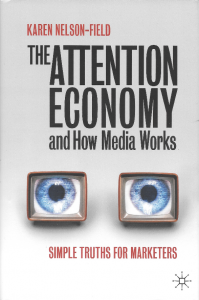The one sentence summary
Gaining the attention of potential customers is much more complicated than the media industry would have us believe.
Can’t be bothered to read it? Too much screen time lately? Listen to the 5-minute podcast.
WHAT THE BOOK SAYS 
- This is all about how media works in a modern context dominated by fake news, fast facts and seriously depleted attention stamina. Rather than simply heralding disruption, this is a conversation about the myths we need to leave behind and what the scientific evidence actually says.
- The concept of viral marketing is utterly flawed because of the nature of the sharing distribution (a reverse J-shape curve). The likelihood of a video spreading to millions from a small seed is highly unlikely.
- Hyper personalisation creates a web of one or a filter bubble, in which you just see the same stuff all the time.
- A brand’s customer base typically looks like a banana (a reverse J-shape distribution) technically called a Negative Binomial Distribution (NBD). There’s no point in trying to increase the purchasing of already heavy users. Big brands have more loyal users but they are loyal to several brands not just one. This NBD Dirichlet shows that the path to growth is less a marketer’s choice than a statistical certainty.
- Advertising impact is therefore small but positive. It doesn’t persuade, it provides publicity.
- Attention and viewability are not the same thing. Viewability is a media owner output (ability to see advertising), whereas attention is a consumer output (whether they watch or not). For example, a youtube ad could have 25% coverage of a viewer’s screen (a quarter of it) with 100% pixels (the whole ad in view). If the pixel level falls to, say, 70%, the brand name could be missing from the ad.
- STAS is short term advertising strength. The greatest uplift in sales impact is when a viewer moves from a non-attentive state to a low attention one. In other words, high attention is not essential for success.
- qCPM is quality cost per thousand. The tricky bit is establishing the extent of the quality – no easy task. Metrics include CPCV (cost per completed view) and AVOC (audible and visible on complete).
- In one study, 88% of digital ad clicks were deemed fraudulent (bots account for over 60% of all website traffic and 18% of impressions).
- There will be a crash in AdTech because digital advertising doesn’t work.
- Buying reach from big online media, but not knowing how many impressions are real, might not actually deliver any unique viewers at all.
WHAT’S GOOD ABOUT IT
- Attention is fleeting. Human capacity is low and we are overloaded.
- Advertising is incidental. It’s a small part of lives, so doesn’t command that much attention. Advertising is not a pervasive force and we buy habitually.
- Top-down triggers can work, when something is truly relevant to a potential customer. Bottom-up triggers can be generated through unexpectedness, which improves the chance of them paying some attention.
- Blitzscaling is attaining explosive growth, lightning fast. This is 10% growth a day, rather than a year. In this regard, companies like Facebook and Google have become accidental media companies.
- A numberwang is a statistic you can bandy around that sounds impressive but, with a bit of context, is less so.
- When a study is claiming a single instance breakthrough, wait for a repeated result before changing course.
WHAT YOU HAVE TO WATCH
- This is a very technical book that will only appeal to media specialists.
- A lot of the data in it was researched by the author’s company, so sometimes it feels a little like a highly detailed brochure.
